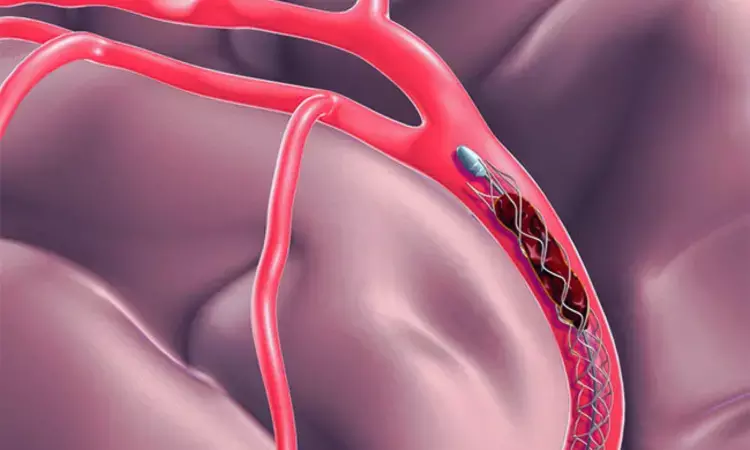- Home
- Medical news & Guidelines
- Anesthesiology
- Cardiology and CTVS
- Critical Care
- Dentistry
- Dermatology
- Diabetes and Endocrinology
- ENT
- Gastroenterology
- Medicine
- Nephrology
- Neurology
- Obstretics-Gynaecology
- Oncology
- Ophthalmology
- Orthopaedics
- Pediatrics-Neonatology
- Psychiatry
- Pulmonology
- Radiology
- Surgery
- Urology
- Laboratory Medicine
- Diet
- Nursing
- Paramedical
- Physiotherapy
- Health news
- Fact Check
- Bone Health Fact Check
- Brain Health Fact Check
- Cancer Related Fact Check
- Child Care Fact Check
- Dental and oral health fact check
- Diabetes and metabolic health fact check
- Diet and Nutrition Fact Check
- Eye and ENT Care Fact Check
- Fitness fact check
- Gut health fact check
- Heart health fact check
- Kidney health fact check
- Medical education fact check
- Men's health fact check
- Respiratory fact check
- Skin and hair care fact check
- Vaccine and Immunization fact check
- Women's health fact check
- AYUSH
- State News
- Andaman and Nicobar Islands
- Andhra Pradesh
- Arunachal Pradesh
- Assam
- Bihar
- Chandigarh
- Chattisgarh
- Dadra and Nagar Haveli
- Daman and Diu
- Delhi
- Goa
- Gujarat
- Haryana
- Himachal Pradesh
- Jammu & Kashmir
- Jharkhand
- Karnataka
- Kerala
- Ladakh
- Lakshadweep
- Madhya Pradesh
- Maharashtra
- Manipur
- Meghalaya
- Mizoram
- Nagaland
- Odisha
- Puducherry
- Punjab
- Rajasthan
- Sikkim
- Tamil Nadu
- Telangana
- Tripura
- Uttar Pradesh
- Uttrakhand
- West Bengal
- Medical Education
- Industry
Thrombectomy promising for Stroke with Large Infarct of Unrestricted Size, unravels study

France: In medical breakthroughs, the recent trial focusing on thrombectomy for stroke with a large infarct of unrestricted size has ignited hope among healthcare professionals and patients alike. This groundbreaking study, conducted by a consortium of leading medical institutions, has unveiled promising results that could potentially revolutionize the treatment landscape for individuals grappling with debilitating strokes.
The LASTE trial showed that thrombectomy plus medical care resulted in better functional outcomes and lower mortality than medical care alone but led to a higher incidence of symptomatic intracerebral hemorrhage in patients with acute stroke and a large infarct of unrestricted size.
"At 90 days, the median modified Rankin scale score was 4, indicating moderately severe disability, in the thrombectomy group versus 6 in the control group, indicating death (generalized OR 1.63)," the researchers reported in the New England Journal of Medicine. Scores of 5 and 6 were combined into one score in the analysis.
Death from any cause occurred in 36.1% of patients in the thrombectomy group compared with 55.5% of those in the control group (adjusted relative risk [aRR] 0.65, 95% CI 0.50-0.84) at 90 days. The benefits of thrombectomy were sustained at 180 days.
The trial, meticulously designed and executed with precision, sought to address a critical gap in stroke management: the lack of effective treatment options for patients with large infarcts of unrestricted size. Traditional thrombectomy procedures have typically been deemed ineffective or risky in such cases, leaving healthcare providers grappling with limited therapeutic avenues and patients facing bleak prognoses.
Caroline Arquizan, MD, of the Hôpital Gui de Chauliac in Montpellier, France, and colleagues aimed to investigate the use of thrombectomy in patients with acute stroke and a large infarct of unrestricted size.
For this purpose, the researchers included patients with proximal cerebral vessel occlusion in the anterior circulation and a large infarct (as defined by an Alberta Stroke Program Early Computed Tomographic Score of ≤5; values range from 0 to 10) detected on magnetic resonance imaging (MRI) or computed tomography within 6.5 hours after symptom onset. They were randomized in a 1:1 ratio to undergo endovascular thrombectomy and receive medical care (thrombectomy group) or medical care alone (control group).
The study's primary outcome was the score on the modified Rankin scale at 90 days (scores range from 0 to 6, with higher scores suggesting greater disability). The primary safety outcome was death from any cause at 90 days, and an ancillary safety outcome was symptomatic intracerebral hemorrhage.
Three hundred and thirty-three patients were assigned to either the thrombectomy group (166 patients) or the control group (167 patients); because of consent withdrawal or legal reasons, 9 were excluded from the analysis.
The researchers reported the following findings:
- The trial was stopped early because the results of similar trials favored thrombectomy.
- Approximately 35% of the patients received thrombolysis therapy. The median modified Rankin scale score at 90 days was 4 in the thrombectomy group and 6 in the control group (generalized odds ratio, 1.63).
- Death from any cause at 90 days occurred in 36.1% of the patients in the thrombectomy group and 55.5% of those in the control group (adjusted relative risk, 0.65), and the percentage of patients with symptomatic intracerebral hemorrhage was 9.6% and 5.7%, respectively (adjusted relative risk, 1.73).
- Eleven procedure-related complications occurred in the thrombectomy group.
The findings showed that in patients with acute stroke and a large infarct of unrestricted size, thrombectomy plus medical care resulted in lower mortality and better functional outcomes than medical care alone but led to a higher incidence of symptomatic intracerebral hemorrhage.
Reference:
Costalat V, et al "Trial of thrombectomy for stroke with a large infarct of unrestricted size" N Engl J Med 2024; DOI: 10.1056/NEJMoa2314063
Dr Kamal Kant Kohli-MBBS, DTCD- a chest specialist with more than 30 years of practice and a flair for writing clinical articles, Dr Kamal Kant Kohli joined Medical Dialogues as a Chief Editor of Medical News. Besides writing articles, as an editor, he proofreads and verifies all the medical content published on Medical Dialogues including those coming from journals, studies,medical conferences,guidelines etc. Email: drkohli@medicaldialogues.in. Contact no. 011-43720751


